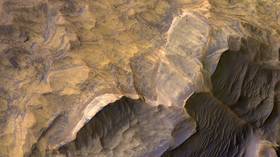Meteoric majesty: Geminids provide spectacular celestial fireworks display in stunning VIDEOS
The Geminids meteor shower peaked overnight, with several spectacular sights captured on camera. For stargazers that missed out, fear not, as the celestial fireworks are set to continue for a few more days.
Regarded by many in the astronomy community as the best meteor display of the year, the Geminids peaked at around 50 meteors per hour. Eyewitness footage from around the world captured the phenomenon, caused by the debris trail of the asteroid 3200 Phaethon.
Some Real-Time Footage of the Geminid Meteor Shower last night from southeast england! Check the full video on my Facebook Page:https://t.co/PoZeQDfAM4@Met4CastUK@UKWX_@WX_Central@UKWeatherChase@XtremeUKWeather@metdesk@metoffice@neiltyson@ProfBrianCox@severeweatherEUpic.twitter.com/K748sgAXeE
— James Woodin (@James_Woodin) December 13, 2020
I saw Geminid meteor shower today 😭😭😭😭😭Soo pretty😭💕 pic.twitter.com/zDLost7fFZ
— Lamia♡ (@Fantasy0228) December 13, 2020
Geminid meteor shower | NIGHTLAPSE | Peak hoursDecember 13-14, 2020 | 7:30 pm - 2:22 am📍 Lucena City, Quezon Province | The Philippineshttps://t.co/bm8i67zSunhttps://t.co/N83EUxBWg6https://t.co/4xquGa6IjUhttps://t.co/XVoQt1Gdhspic.twitter.com/fldTil31jV
— Caloy (@JCGatdula_) December 14, 2020
Tonight is the peak of the Geminid Meteor Shower!We could see around 50 per hour in the clear skies of Norway! All our equipment is ready and we're really excited!Here's a quick video from a few nights ago with a few meteors 😊@StormHour@StormchaserUKEU@NightLights_AMpic.twitter.com/tFiTLeUej0
— Matt Robinson (@Astromackem) December 13, 2020
“[T]he predicted rate for observers in the Northern Hemisphere is closer to 60 meteors per hour,” NASA officials wrote. “This means you can expect to see an average of one Geminid per minute in dark skies at the shower peak.”
The Slooh online observatory, which remotely operates a number of telescopes around the world, also carries a live stream of the event.
Meanwhile, NASA's own Marshall Space Flight Center is hosting a live event on Monday night as well, beginning at 9pm EST. The original NASA webcast on Sunday was unfortunately delayed as a result of cloud cover.
For those hoping to venture outside and brave the elements for a glimpse at the meteoric majesty, they should direct their gaze towards the constellation Gemini, the point from which the meteorites appear to originate in the sky (hence the name).
Midnight to 4am local time typically yields the best viewing conditions, according to NASA.
Also on rt.com Space objects getting closer: As scientists welcome samples from asteroid Ryugu, NASA sounds alarm over 5 incoming rocksAs always, the advice for those hoping to watch the meteor shower is to get as far away from sources of light pollution as possible, allow 30 minutes for your eyes to adjust to the darkness, dress warmly, and consider bringing a lawn chair or blanket so you don't strain your neck.
NASA also advises not to neglect the rest of the sky, as focusing too much on the Gemini constellation will reduce the likelihood of observing the meteors' short trails from different viewing angles. Given that the Geminids travel at 78,000 mph (35 km/s), or 40 times faster than a bullet, it’s best to give yourself a better chance of seeing as many meteors as possible.
Thankfully, the shower’s peak overlaps with a nearly new moon, meaning darker skies against which the meteors will burn brightly, with little to no moonlight obscuring the view.
Also on rt.com Global mass extinctions follow regular 27-million-year cycle, may be linked to Earth’s journey through Milky WayThink your friends would be interested? Share this story!













